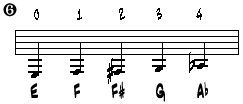Reading/Sight Reading
Reading music is a funny thing for guitarists. The reasons for this are well understood:
• Most guitarists start out playing Rock, learning Purple Haze and some bar chords, the blues scale. No reading necessary.
• The guitar is a strange instrument to sight read on. There are many ways to play the same thing; some notes have four practical places to play them. These are options most other instruments don’t have.
A Brief Rant
Taking the above into account, TAB was developed to take the place of reading notes. However, this presents a problem:
No jazz musician will EVER put a piece of TAB in front of you at a rehearsal or a gig. Nobody who plays another instrument even knows what TAB is. This means that reading music is a necessity if you want to work at a high level, since everyone that you will be playing with can read music.
I also feel that reliance on TAB sends the wrong message to guitarists and electric bassists—that you are too stupid to read music. Think about it. Guitarists are not stupid, and you are insulting yourself if you think that you can’t learn to read. Of course you can read. You can even become a good sight reader.
Raising the overall level of reading has positive effects. Currently, and since the beginning of time (around 1950), arrangers and composers know that if they write something complex for guitar, it won’t be read well. So they don’t write for guitar, so guitarists have no reason to work on reading, so they don’t read well, so composers don’t write……..
As with anything else, reading simply takes practice, aka, consistent repetition.
Reading Fundamentals • Note Names
Written music tells you two things:
• What pitch to play, and
• When to play it in relationship to the meter (rhythm).
There are only 12 pitches to learn, then the names repeat. C, D, E, F, G, A, B are the basic note names, and the other pitches are sharps (#) and flats (b) (the black keys on the piano). A sharp (#) raises a pitch by one half step, or on the guitar neck, one fret. A flat (b) lowers a pitch by a half step.
Start with the low E string. The open string is, you guessed it, E. It looks like this:

The first fret is F:

The third fret is G

The note in between F and G, at the second fret, has two names— F# or Gb. The note(s) look like this (notice that the sharp and flat signs appear before the note).

Below are the notes on the neck from the open string to the fourth fret:





